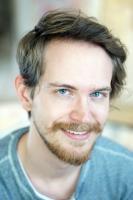Chances are you've never really heard anything quite like the music of Cody Kauhl. Comprised of found and ambient sounds, sung vocals and computer-generated sounds, Kauhl's music, in his words, investigates "the hidden musical potential of urban noise pollution while utilizing new methods of human and computer interaction." For this edition of Listen Local, Kauhl shares some recent music and videos and sheds light on his creative process and the often collaborative nature of his craft.
*
Introduce yourself. Where do you live and work? What does a typical day look like for you?
I’m a Kansas City-based composer and digital multimedia artist that frequently collaborates with local choreographers, composers, and visual artists. I live in Southtown Kansas City and work downtown during the day. Most days I take care of correspondence and technical facets of my art practice first and then reward myself with the more creative bits (that’s where coffee comes in!). On weekends, places like Crow’s Coffee at 51st and Brookside are wonderful to enjoy the sun and create art in a bustling yet productive environment. In between meetings with collaborators and other colleague’s exhibitions or concerts, typical days are often quite atypical.
Describe your creative process. What tools do you use? How do you go about finding and manipulating your sound sources?
My creative process is highly informed by my previous work and how I want to improve upon it. If I’m not convinced by a certain aspect of my most recent work, I am inclined to try the polar opposite approach in the next piece. In the process of its creation, that aspect often becomes something in between, which is often for the best.
I played a lot with Legos as a child and I envision the art I want to create much like how I used to plan and build new Lego creations. The sound or video samples I collect act as the building blocks and I then find elegant methods to construct the piece I imagine. I use Ableton Live to create music, Adobe Premiere to produce video, and Max by Cycling 74 to program unique audio effects and digital multimedia instruments utilizing cameras and sensors.
I collect my sound and video sources wherever I go. If for a piece I can’t easily procure a certain sound I have in mind, I can often find it on collaborative sound databases. For those sounds I collect myself, I post the original files to these databases as creative-commons, aiding others with similar endeavors. In order to preserve the moving image or sound’s natural characteristics, I tend to impose very little manipulation on the source recording. Instead I rely upon finding creative ways to arrange these samples so that it either transcends or heightens its original meaning.
How do you break through creative blocks?
I visualize creative blocks less as a “block” and more of an increasing exponential curve that has the potential to stand between myself and what I hope to create. For me, a creative block doesn’t immediately impose itself but can slowly creep up if I’m not careful. The only way to keep this exponential curve from rising is constantly finding new angles to look at what I’m making. If I’ve been working with a piece too long and am unsure of what to do next, I often put it down for a bit and work on something else or go for a walk. After I have gained some objectivity to the piece, I return to it and experience it in a new environment; this may be a different room, or a new place altogether. From there, I can usually feel what’s been missing and resume.
Tell us about your upcoming position as Composer-in-Residence at the Brush Creek (WY) Foundation for the Arts. What do you have planned?
Two months ago, the Brush Creek Foundation for the Arts furnished me with a residency in which I was provided a log cabin workspace, separate living space, and fully catered meals, so that I may create art unimpeded for the month of February. There I laid the groundwork programming for a collaboration with choreographer Brooke McPheeters in which two infrared cameras read and create music from the dancers’ movement. I also finished ‘Aurum’ a short video art piece, shown below. Finally, I recorded and produced an electrofolk cover of old Doc Watson tune, which will make its appearance with other electrofolk originals and reinterpretations on a near future CD release!
Who or what inspires you?
For me, inspiration comes from film, visual art, music, most any creative medium, but all of these sources share the same attributes as being intimate, honest, and understated on the surface yet shaded and detailed upon closer inspection. I like to be able to see straight into the creator’s soul through their music, whether it has vocals or is purely instrumental. Of the recommendations not listed below, I’m also highly inspired by artists such as Canon Blue, Ben Frost, Efterklang, and Fionn Regan. All of these musicians share this intimate honesty I strive to produce in my own music.
*
Cody's recommendations:
Carrie & Lowell by Sufjan Stevens
Vespertine by Bjork
Gone Girl (Soundtrack) by Trent Reznor/Atticus Ross
Bright Sunny South by Sam Amidon
Benji by Sun Kil Moon
WTC 9/11 by Steve Reich
They Want My Soul by Spoon
Death Speaks by David Lang

